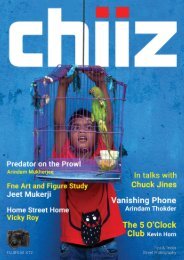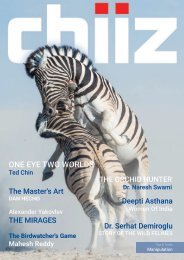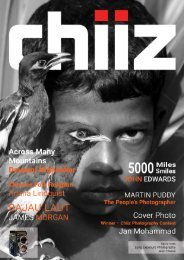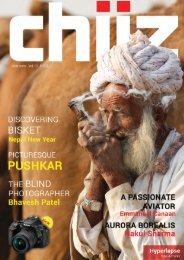Chiiz Volume 11 : Macro Photography
Macro is the genre of photography, which when perfectly captured, can take you to a different world. Be it flowers, birds, insects or any such regular subject present in our surrounding, appears completely different in the zoom lens. When it comes to macro, it requires both skills and patience. This volume is obliged to deliver you with fascinating content. The work of Nicky Bay will leave you in amusement. The beauty pf underwater world of wonderfully captured by Rudo Hvizdos. Exit Hamster will take you on a trip to Oktoberfest through his pictures. Michael Doe’s Project Maratus will introduce you with the prettiest spiders in the world. Pictures by Abd Al-rhman Nafez Hammad are simply a work of excellence. Huub De Waard provides you with the tips to capture Macro Life. The pictures of fine art nude photography, the Muses, will leave you in awe and admiration by its marvelous photography. Find this lot more amazing content in the issue.
Macro is the genre of photography, which when perfectly captured, can take you to a different world. Be it flowers, birds, insects or any such regular subject present in our surrounding, appears completely different in the zoom lens.
When it comes to macro, it requires both skills and patience. This volume is obliged to deliver you with fascinating content. The work of Nicky Bay will leave you in amusement. The beauty pf underwater world of wonderfully captured by Rudo Hvizdos. Exit Hamster will take you on a trip to Oktoberfest through his pictures. Michael Doe’s Project Maratus will introduce you with the prettiest spiders in the world. Pictures by Abd Al-rhman Nafez Hammad are simply a work of excellence. Huub De Waard provides you with the tips to capture Macro Life. The pictures of fine art nude photography, the Muses, will leave you in awe and admiration by its marvelous photography. Find this lot more amazing content in the issue.
You also want an ePaper? Increase the reach of your titles
YUMPU automatically turns print PDFs into web optimized ePapers that Google loves.
Drone Fly<br />
Canon EOS 7D 65mm F/16 1/250s ISO100<br />
Tips and Tricks<br />
<strong>Macro</strong> <strong>Photography</strong><br />
Huub<br />
de Waard<br />
The compound eyes of insects, consisting of<br />
a large number of ommatidia, have always<br />
fascinated me. To uncover as much detail as<br />
possible I photograph insects so extremely<br />
close that they seem to have a gigantic size.<br />
At that scale insects of the same species look<br />
very different and each insect seems to have<br />
its own character.<br />
Magnification describes the relationship<br />
between the actual size of the subject and<br />
the size of its image on the sensor of the<br />
camera. Dividing the size of the subject’s<br />
image on the sensor by the actual size<br />
determines the magnification. At 1:1 lifesize,<br />
the size of the subject on the sensor is<br />
as big as it is in real life. <strong>Macro</strong> <strong>Photography</strong><br />
is restricted to magnifications in the order of<br />
1:10 to 1:1 life-size. When this magnification<br />
is reached, shooting from life-size to<br />
modest magnifications of up to 20 is called<br />
microphotography.<br />
Larger than life-size<br />
Most macro lenses are maximally able to<br />
capture a 1:1 life-size image of a subject on the<br />
camera’s sensor. Microphotography can be<br />
undertaken by normal macro lenses equipped<br />
with modestly specialized equipment. A lens’<br />
minimum focusing distance is the closest<br />
distance your macro lens will allow you to get<br />
to your subject while still maintaining sharp<br />
focus. A low-budget method to decrease the<br />
minimum focusing distance is to extend the<br />
distance between the lens and the sensor by<br />
inserting extension tubes or a continuously<br />
adjustable bellows. Both the extension<br />
tubes and the bellows do not contain optical<br />
elements. The further the lens is from the<br />
sensor, the closer the minimum focusing<br />
distance, the greater the magnification, and<br />
the darker the image given the same aperture.<br />
By adding a teleconverter, an even greater<br />
magnification can be achieved. Application<br />
of a 2x teleconverter produces a maximum<br />
magnification of 2 and 2 stops loss in light<br />
intensity. Placing an auxiliary close-up lens<br />
(or close-up “filter”) in front of a macro lens<br />
is another option. Inexpensive screw-in or<br />
slip-on attachments provide close-focusing at<br />
a very low cost.<br />
Approaching Insects<br />
Although most insects do not have orifices in<br />
their body for picking up sound vibrations,<br />
many use parts of their body, such as<br />
their wings, antennae, or special hairs,<br />
like TV antennae to detect vibrations in<br />
the environment or in the air. Any errant<br />
movement on your part could cause you to<br />
lose a shot, so be sure to tread carefully when<br />
approaching your subjects. The first thing<br />
you want to do is to move very slowly. Look<br />
before you move, look at where you place<br />
your feet, look at where your equipment is,<br />
and most of all plan where you are going to<br />
put the front of your lens. Many potentially<br />
good shots have been ruined by the front of a<br />
lens bumping a branch or leaf where an insect<br />
was resting, causing it to flee.<br />
Most insects have a view of the world that is<br />
very different from ours. These eyes are made<br />
24 Vol <strong>11</strong>












